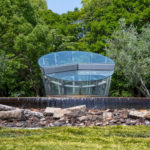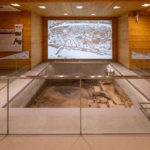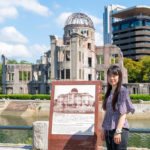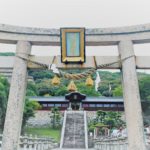2 Complete Destruction of School Buildings by the Atomic Bombing and the End of the War
One morning when children were on their way from the temples to school, they felt the windows rattling and saw a yellow light flash in the distance. At the time, they did not pay much attention and finished their day at school16). However, in the evening on that same day, trains with a huge number of injured people began to arrive one after another. Apparently, there had been a large-scale attack on Hiroshima. The city was in a state of unimaginable devastation. On 6 August 1945, at 8:15 am, when the atomic bomb was dropped, there were 13 faculty members and about 400 children at Honkawa National School (approximately 350 meters from the hypocenter) 17). At Sorasaya Shrine, which was near the school, together with their teachers, about 50 children who were in the first and second grades were praying for victory 18). On that day, air-raid warnings were broadcast at 7:09 am and people evacuated to bomb shelters for a short time, but the warnings were lifted at 7:31am 19). Hence, when the atomic bomb detonated, few people were in shelters. The blast of the atomic bomb destroyed the whole school building except the reinforced steel frame. Six faculty members, including the principle, and 218 schoolchildren, were killed on the spot, and a tremendous number of people were injured or missing20). Soon after the incident, the school became a temporary aid station centered on the first floor of the west building. At the aid station, along with an army medical branch, survivors volunteered to give aide to the injured and to handle bodies21). On the playground, many identified corpses were cremated. The Hiroshima that one 14-year-old boy witnessed was “a city covered by a field of rubble, anguished people whose faces were so blistered that one could not tell eyes from noses amidst a pool of blood, smoldering bodies thrown into holes filled with black rain; a city covered in bleached bones22).”
On the other hand, in the rural areas, along with the injured from Hiroshima City, information about the damage began to trickle out. Initially, it was not known exactly what had happened in Hiroshima. However, schools in the rural areas became hospitals and classes were cancelled23). When children came back to the temples, they were told that Hiroshima had been attacked. They collapsed in tears in the corner of the main hall. Teachers comforting the children were also crying24). Soon after the news arrived, male teachers headed to Honkawa National School from the countryside to which they had been evacuated in order to collect information and gauge the extent of the damage 25). Parents and relatives who had survived picked up their children and went back home26)) . During those days, faculty members were busy verifying the relatives of schoolchildren and taking care of children who had lost their families27).
After that, on 15 August, the Emperor’s famous radio address was broadcast, marking the end of the war. In the countryside, where people had been evacuated, foreign prisoners were released and training aircraft were burned in rice paddies28). Although the school evacuation was lifted soon after, for many children, nobody came to get them. Those children who had no place to go had no options but to stay in the temples for the time being29). It was not until September that all the evacuated children were taken 30).
From that time, school education was compelled to make major changes. On 6 October, Senji Kyouiku Rei (Education Law during the Wartime) was abolished. On 31 December, GHQ (General Headquarters, the Supreme Commander for the Allied Powers) issued Suspension of Courses in Morals (Shushin), Japanese History, and Geography 31). As a result, traditional subjects including Morals (Shushin), Japanese History and Geography were abolished and textbooks were scrapped accordingly.
16)Ibid, pp 131
17)“Gakudosokai deno Seikatsu no Jittai” (Reality of Evacuation of Schoolchildren), In Senchu Sengo ni Okeru Hiroshimashi no Kokumin Gakko Kyouiku” (National School Education in Hiroshima during and after the War),p.310
18)“Gakudosokai deno Seikatsu no Jittai”(Reality of Evacuation of Schoolchildren), In Senchu Sengo ni Okeru Hiroshimashi no Kokumin Gakko Kyouiku”(National School Education in Hiroshima during and after the War), p.310
19)“Gakudosokai deno Seikatsu no Jittai” (Reality of Evacuation of Schoolchildren), Senchu Sengo ni Okeru Hiroshimashi no Kokumin Gakko Kyouiku” (National School Education in Hiroshima during and after the War), p.299
20)“Gakudosokai deno Seikatsu no Jittai”(Reality of Evacuation of Schoolchildren), In Senchu Sengo ni Okeru Hiroshimashi no Kokumin Gakko Kyouiku” (National School Education in Hiroshima during and after the War), p.298
21)Honkawachiku Genbaku Ireishi Kensetsu Iinkai (1995), p.41
22)Honkawa Elementary School (1973) “Hiroshimashi Genbakusensai Shiryouhyou” (List of A-bomb Damage in Hiroshima City), In Souritsu Hyakushunen Kinenshi‘Memorial Magazine of 100th Anniversary of Establishment), Hiroshima Elementary School Executive Committee of 100thAnniversary of Establishment, pp137
23)Mutsuko Goto (1973),“Tomoyo Izukoni: Shuudan Sokaiseikatsu no Danpen” (Where are my friends?: Fragments of Group Evacuation), In Souritsu Hyakushunen Kinenshi‘Memorial Magazine of 100th Anniversary of Establishment), Hiroshima Elementary School Executive Committee of 100thAnniversary of Establishment), p.142
24)Ibid. pp142
25)Hiroshimashi Genbakusensai Shiryouhyou” (List of A-bomb Damage in Hiroshima City), p.137
26)Tomoyo Izukoni: Shuudan Sokaiseikatsu no Danpen” (Where are my friends?: Fragments of Group Evacuation), p.138
27)“Hiroshimashi Genbakusensai Shiryouhyou” (List of A-bomb Damages in Hiroshima City), p.137
28)“Gakudosokai deno Seikatsu no Jittai” (Reality of Evacuation of Schoolchildren), pp131-pp132
29)Ibid, pp132
30)“Gakudosokai deno Seikatsu no Jittai” (Reality of Evacuation of Schoolchildren), In Senchu Sengo ni Okeru Hiroshimashi no Kokumin Gakko Kyouiku” (National School Education in Hiroshima during and after the War)p.310
31)Hiroshima City Board of Education (1981), “Nenpyouhyou” (Chronology Table), in Hiroshimashi Kyouikuiinkai 30 nen no ayumi (30 Year-Hisotry of Hiroshima City Board of Education), Hiroshima City Board of Education, p.160
Tags associated with this article








